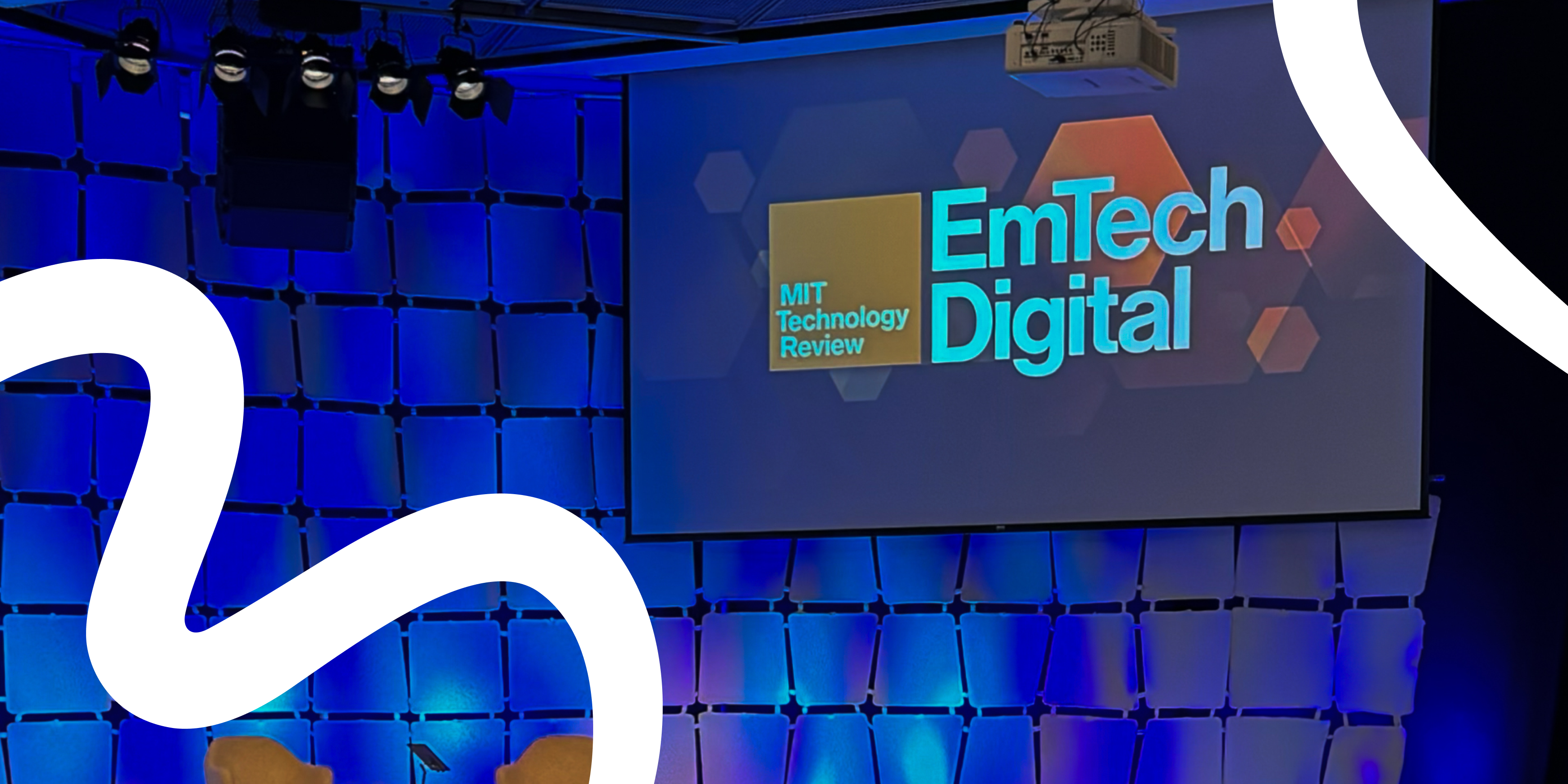
AI Highlights from EmTech Digital 2024
-
 Carlo Rapisarda
Carlo Rapisarda
For the very first time this year, we decided to take part in EmTech Digital, MIT Technology Review’s conference on emerging technologies, with a special focus on Artificial Intelligence. The conference spans two days and is packed with talks about AI and its impact on the workforce, democracy, and innovation. This year, the topics were divided into two macro areas: Harnessing the Power of AI and Accelerating AI Innovation.

These events tend to be an echo chamber of resonant opinions, but what I especially liked about this year’s EmTech Digital is that for every overly optimistic talk, another speaker presented a matching dissonant point. We saw giants like OpenAI and NVIDIA show off their latest tech, and policy experts advocating for heavy regulation, we heard Meta’s Nick Clegg discussing the company’s controversial approach towards AI, and Private AI’s CEO Patricia Thaine highlighting the importance of protecting personal information as part of AI development. These clashing viewpoints resulted in some truly insightful conversations, both during the Q&A sessions and among attendees, and turned out to be nearly as valuable as the talks themselves.
Here’s what I learned during these two days and what I think are some highly relevant insights for those who want to design the best digital experiences in a world with pervasive AI tech.
First Impressions
The conference took place at MIT Media Lab on the MIT campus in the beautiful Boston suburb of Cambridge. I arrived early on the first day, picked up my attendee badge, and headed to the main event hall for breakfast and some networking. At this point, the hall was mostly empty, with a few early birds trying to orient themselves, some stations from the event sponsors, and scattered refreshment tables (with great snacks but questionable coffee).
.png?width=1000&height=500&name=Untitled%20design%20(6).png)
After a quick scan around the room and some awkward, mouth-filled small talk with the attendees, I realized the audience of the event was quite heterogeneous. I met business owners, CEOs, and sales specialists, but also engineers, artists, and policymakers; similarly, the representation of different backgrounds (other than occupation, that is) was noticeably better compared to previous years from what I heard — although there’s always room for improvement. I believe this blend of perspectives is key to sparking interesting and valuable conversations, so I was looking forward to having more interactions. Before I could find the next person to talk to, though, a gentle chime started to ring, leading everyone into the auditorium for the first presentation.
The Talks
Fair, Private, and Compliant AI
As tech giants grow more and more data-hungry, users start to lose trust, and policymakers start enforcing new regulations. Artificial Intelligence is often at the center of controversies around data usage, and so it was certainly no surprise when many of the talks at EmTech Digital focused on this particular issue.
We might be curious to see what happens in a dispute like OpenAI vs. The New York Times or concerned as users of apps like Instagram - insisting on consuming our data to train AI models or showing us AI-generated political ads. For us digital product designers, though, this topic should no longer be a matter of curiosity; as we start integrating AI-powered features or building entire products around these models, we must incorporate strong principles that respect and are fair to our users and society at large. And it’s not just about regulatory compliance, it’s about building and maintaining trust with users, and ultimately having a positive impact on this world.

The brand new EU AI Act was mentioned and praised by multiple speakers, and it really does set a great example. It will come into force once published in the Official Journal of the EU (most likely this summer), and become applicable in stages over 6-36 months (depending on the risk classification of different sectors). The policies seem straightforward and more than fair to me: for instance, we’ll have to make sure to correctly label AI-generated outputs within our products. As Christabel Randolph pointed out during her talk on guardrails, the EU AI Act seems balanced enough to protect users without slowing down progress; at the same time, Christabel highlighted how the US is still lacking a unified federal framework on AI and pressure from the industry and other global players (like China) is not likely to help regulators take concrete steps
Human and Machine Collaboration
There’s also another aspect that revolves around the usage of generative AI — language models in particular — within the work environment. How do we make sure employees are empowered by AI instead of feeling like they are being replaced? How can we exploit the latest tech without fearing it might make our decisions, our recruiting processes, and our design systems more biased and unfair? How do we make sure personal information or intellectual property isn’t accidentally leaked into some training dataset?

These are all questions we have to answer as we integrate these systems into our workflows. People like Julie Shah — Professor of Aeronautics and Astronautics at MIT — are trying to do just that. Julie is leading an interdisciplinary project exploring how companies across different sectors — healthcare, finance, IT — are adopting Artificial Intelligence for productivity, supporting decisions, and innovation. During her talk, she brought up the classic historical examples of society fearing automation would replace jobs and how jobs have instead evolved to embrace automation. I am personally convinced that Artificial Intelligence is profoundly different from other forms of automation we’ve seen in the past, and that this parallelism doesn’t really apply, however I don’t think fatalism is the answer. The best one can do is to accept that progress can’t be stopped, continue to learn about the latest tech instead of fearing it and embrace the wins we get along the way.
An example of one of these wins is certainly the incredible new tools being developed for artists and designers. Adobe is a huge player in the field, and they’re investing a lot to make sure they don’t remain behind when it comes to Generative AI tools. Their Firefly product allows creatives to generate images from scratch, fill or replace parts of existing images, and even generate vector graphics.

During her talk, Jingwan (Cynthia) Lu — Head of Applied Research GenAI at Adobe — introduced brand new features coming to Illustrator and powered by Firefly models, including Generative Fill and Generative Expand (these were already available for bitmap images in Photoshop, but now also work on vector graphics); she showed a quick demo of these new capabilities, and they certainly left me impressed (although I’m not a designer myself 😄). Finally, Jingwan gave us a sneak peek at future models Adobe is working on, including audio, video, and 3D asset generation.
At Bontouch, we are thrilled about the possibilities these new tools unlock. We have been exploring them for quite some time as part of our design processes and beyond.
Tailormade User Experiences

One of the most inspiring talks was held by Peter Smart — CXO and managing partner at Fantasy — on Generative Interfaces. Many of the digital products we use today rely on a one-size-fits-all design; this might result in a mediocre experience for most users but only an excellent experience for very few. Additionally, to complete a task, users are often required to switch contexts between different services or apps, which takes time and contributes to a poor experience overall.
Peter instead advocates for digital experiences that are designed to adapt to individual users, fitting their specific needs and preferences. Layouts, features, and content could be personalized in real time, thanks to the latest AI advancements. Requests for more information could be fulfilled without switching context, with the results inserted within the same user interface and stored for later use. At the core of generative interfaces, there would be modular components, or blocks, designed to present dynamic, adaptive content as dictated by an AI model.
A product built in such a way — with generative interfaces — would allow users to achieve their tasks more efficiently and easily, improving their satisfaction and loyalty and reshaping the relationship they have with technology. This is all already possible today, so Smart claimed it’s high time to get ready for product teams that want to embrace this approach. Adopting generative interfaces will require new skills, investments in AI capabilities, and a considerable shift away from traditional design and development frameworks. At Bontouch, we are incredibly excited about the opportunities this approach will unlock. We have already started experimenting with some of our partners.
A More Nuanced Discourse

Finally, something that really got me thinking was an important point made by Jay Yagnik in his talk. Jay is currently leading large parts of Google’s AI efforts, and his presentation was about the history, the current state, and the potential future of Artificial Intelligence. His key point, though, was that very often, predictions around technological advancements fall into utopian or dystopian extremes, fueled by sensationalism. AI has now reached one of these critical junctures, with the vast majority of the public jumping on one ship or the other: you’re either an “AI evangelist” or a devoted AI denier, convinced the technology is useless — or worse — will be the end of us.
The reality is that the path ahead is still uncertain. No one knows how technology will evolve, which pieces of the puzzle are still to be found, or how we will all be impacted. Yagnik explained how crucial it is to advocate for a nuanced discourse on AI on all fronts, involving all stakeholders, including the public. By maintaining a balanced discussion, we can better understand both risks and opportunities, enabling us to develop effective mitigations and leverage the latest advancements for their genuine strengths. In hindsight, this all seems almost obvious, or in any case, quite an easy thing to agree with, but in practice, it’s surprisingly hard to keep in mind, especially when working closely or within the field.
Conclusion

All in all, participating in EmTech Digital this year was definitely a positive experience for me and one that we, as Bontouch, will most likely repeat going forward. I had the opportunity to hear a diverse range of perspectives directly from leaders across this space and engage in important discussions with other attendees.
We have entered a new era full of challenges but also full of fantastic opportunities for the taking. We have the chance to build incredible new experiences within our digital products that were just hard to imagine until now, as well as the privilege to do so with brand-new tools that make us more efficient and eliminate tedious tasks. Approaching this in the right way requires us to keep strong principles in place: humility — to maintain a balanced discourse, integrity — to have a positive impact on society, and user-centricity — to ensure we are solving the right problems. At Bontouch, we are more than ready, and we hope you are too.
If you want to know more or research what Artificial Intelligence means for you and your brand, don’t hesitate to contact us at curious@bontouch.com so we can explore together.